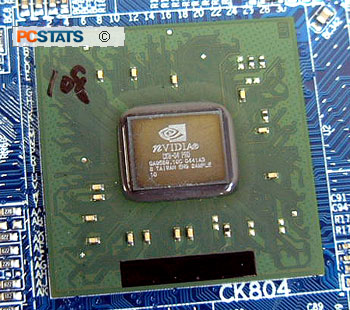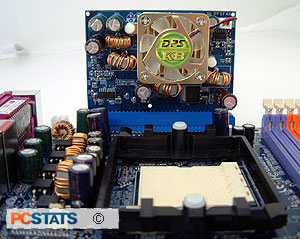 AMD’s line of desktop 64-bit processors, the
Athlon 64 and Athlon FX, have quickly stolen the spotlight away from
Intel. Enthusiasts have eagerly adopted the new Athlon64 processor, mainly because its performance has stood well apart
from comparative Intel processors, especially in the gaming arena.
AMD’s line of desktop 64-bit processors, the
Athlon 64 and Athlon FX, have quickly stolen the spotlight away from
Intel. Enthusiasts have eagerly adopted the new Athlon64 processor, mainly because its performance has stood well apart
from comparative Intel processors, especially in the gaming arena.
Until recently, the newest Intel chipsets boasted
features that Athlon 64 systems could not match, namely PCI
Express and DDR-2 memory.
These two
technologies are the wave of
the future in motherboard design, but the first generation of socket 754/940/939 Athlon 64
chipsets lacked these features. Only now, with the release of nVidia’s
nForce 4 chipset, as well as VIA’s K8T890 and ATI’s Radeon Xpress 200 chipsets, has
PCI-Express support been seen in an AMD-based system. DDR-2 memory will have to
wait for future chipset releases however, but this is not such a major
issue for the Athlon64 now. We’ll explore the reasons for this a bit
later.
While
current video card chipsets from nVidia and ATI are available in both PCI-Express
and the older AGP standard (ie with an HSI bridge, or native), we
are rapidly approaching the point where AGP will be dropped completely from GPU
architectures. Motherboard manufacturers no doubt breathed a sigh of relief
when reference designs for the next generation of motherboard chipsets from nVidia,
VIA and ATI dropped through their mailboxes, since the Athlon 64 platform would
not have been viable for too much longer without PCI-Express support.
 DDR-2
memory is also not a must-have for
motherboards now, and it may be considerably longer before it’s considered as
essential as PCI-Express is. The reason for this is that
DDR-2 RAM is simply an evolutionary upgrade over the existing DDR standard,
slowing down the memory internally to allow for higher external clock speeds.
DDR-2
memory is also not a must-have for
motherboards now, and it may be considerably longer before it’s considered as
essential as PCI-Express is. The reason for this is that
DDR-2 RAM is simply an evolutionary upgrade over the existing DDR standard,
slowing down the memory internally to allow for higher external clock speeds.
For the whole picture, I suggest you take a moment
to read PCstats article on the DDR-2
technology here. Suffice to say that DDR2 is not faster than
regular DDR, it simply allows manufacturers to increase the clock speeds of
their memory to keep up with the increase in processor bus speeds.
Intel
needed DDR-2 RAM support built into their high-end 925X chipset, since they are now
bringing in a line of Extreme Edition Pentium 4 processors with a 1066MHz front
side bus. The increased clock speed of DDR-2 memory is needed to keep up with these
processors.
AMD has
chosen a different route for its Athlon 64 processor. The company has no known plans to
ramp up memory speed demands of its processors in the next little while, and
thus there is no pressing need for DDR-2 memory support in AMD chipsets. As
we mentioned, at the same speeds DDR-2 has no performance advantage over standard DDR
memory.
This brings us
back to nVidia’s introduction of the nForce 4 chipset. Let’s take a look at
what features this next-generation Athlon 64 chipset has to offer.
